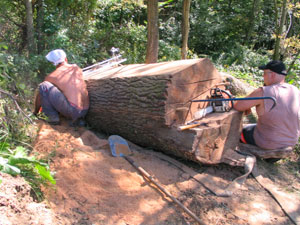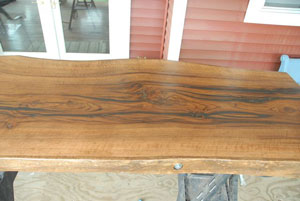
What is Black Oak: That Remains the Question
In one of our Q&A queries in the last issue of the eZine, a reader wondered what exactly some “black oak” he had run across was. In response, we heard from some other readers about their experiences — and their definitions. – Editor
“I saw the questions about ‘black oak’ in the eZine 307. We occasionally work with black oak, and our experience is that it is harder than red oak. It seems to hold its finish well and is dimensionally stable, as you might expect. I attached two photos; one is cutting the bar from the log and the second is finished with Minwax® Early American stain covered with polyurethane.” – Thomas Lobb
“I saw a question asking what is Black Oak. I have a stack of it in my garage, [which] I bought from a friend. It is hard as a rock. Dulls up my Delta planer blades just like that! Some of it looks like ‘normal’ oak, some of it is dark. I think it’s unique! I just wish it weren’t so hard!! I’ll use it up slowly due to the difficulty planing a good piece from it.” – Bob Mayfield
“About ‘black oak’: We have a species of oak in Southeast Texas (probably goes by several names) — I call it water oak. I think it is a type of live oak — keeps its leaves all year. It has streaks of black — some wide, some narrow. Quartersawn generally has wider bands of black than other types of cuts. Makes AMAZING looks in furniture and can be difficult to work.” – David Norris
“In general, there are two groups of oaks: the red/blacks and the whites. The red (Quercus rubra) and black (Q velutina) oaks require two years to ripen the acorns, have sharp-tipped leaf lobes (bristle-tipped), lack tyloses, and are very susceptible to oak wilt and also include pin oak (Q ellipsoidalis), scarlet oak (Q coccinea), and scrub oak (which apparently is a variant of the black oak). In a lumberyard, these will all be red oak.
“The white (Q alba) oaks mature acorns in one year, have rounded leaf lobes, have tyloses, and usually resist oak wilt and include bur oak (Q macrocarpa), swamp white oak (Q bicolor), dwarf chinkapin oak (Q prinoides), and chinkapin oak (Q muehlenbergii). These would all be sold as white oak.
Disclaimers: The quoted scientific names may now be different from what I learned. I have seen bur oak spelled ‘burr’ oak even in tree keys and texts, but I believe the proper spelling is ‘bur.’ I don’t believe any forester or botanist would ever call a bur oak a black oak. Finally, there are quite a few more oaks in the East and South I have not mentioned.” – Dave Siegler
How to Align a Table Saw Fence and Blade
Also in the last issue, there was a question about whether the rip fence and the blade on a table saw should be parallel. Readers had feedback about that as well. – Editor
“The argument regarding the alignment of the fence to the blade on a table saw will go on forever. However, I believe as many woodworkers do. and that is ‘TO ERR ON THE SIDE OF SAFETY’ and set the fence a few thousandths of an inch toed out from the back of the blade. I use a dollar bill folded in half between the back of the blade and the fence. This allows about .006″ and will not affect the quality of the cut and prevent jamming and kickback.” – Paul A. Otto
“In the Q & A section of eZine Issue 307, Dean Brumley asks the question, ‘should the rip fence and saw blade be parallel to each other.’ I am one of the old-time woodworkers and have to disagree with Chris Marshall’s answer. First, there are two kinds of parallel relationships between the saw blade and the rip fence, horizontal and vertical. In the vertical plane, the bottom of the blade and the top of the blade should be 100 percent parallel to the rip fence. As for the horizontal plane, the leading edge of the blade and the trailing edge of the blade should NOT be 100 percent parallel. There are two distinct reasons why. First, the trailing edge of the blade is revolving in an upwards direction, therefore trying to lift the workpiece. Also, if the trailing edge of the blade comes even in slight contact with the workpiece, it can leave swirl marks. Therefore, the rip fence should be slightly farther away from the trailing edge of the blade than it is from the leading edge of the blade. In my 50-plus years of experience, I have found that 1/64th of an inch seems to work just fine.” – M. Keith Green
Strawberry-Rhubarb Pie
Finally, the pie flavor that Rob hinted — merely hinted, mind you! — could potentially sway his State Fair votes — also drew some comments. Interestingly, some folks seem to love that kind of pie — and others have never heard of it. – Editor
“My favorite! Enjoy!” – Alan Falk
“I love rhubarb pie and yellow custard on it. I have never had a strawberry-rhubarb pie. I will have to look out for that. My granny in England used to walk out to the rhubarb bush and cut some stalks and cook it up. Then we waited for the pie and hot custard. After loading it with sugar so our mouths didn’t pucker so badly, we could eat it. That was back in the mid ’70s, and I can almost taste it. My little shop is getting geared up for making crafts for Christmas. I start early so the mistakes can be hidden or destroyed. Enjoy the woodworking show and the state fair.” – Robert Anderson








